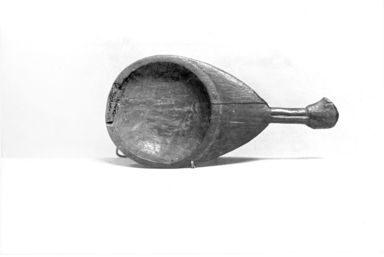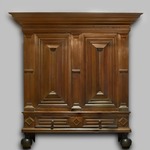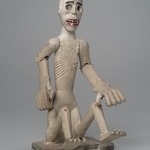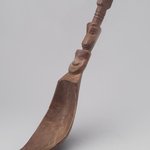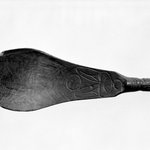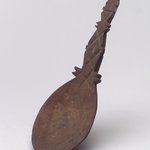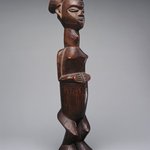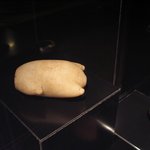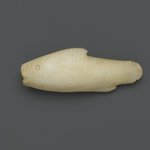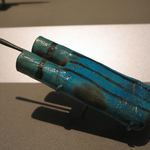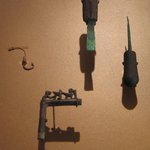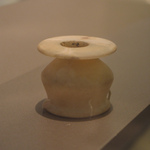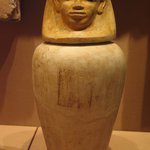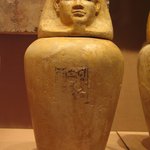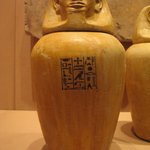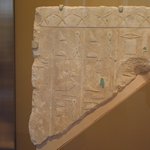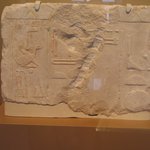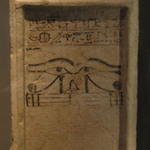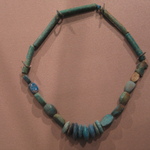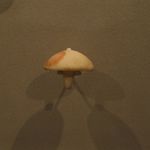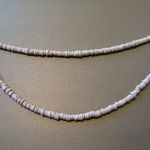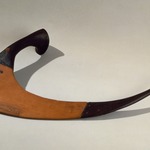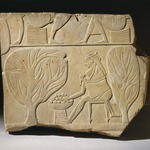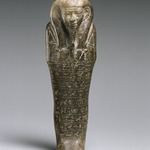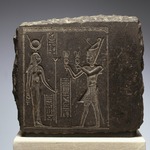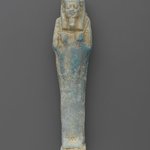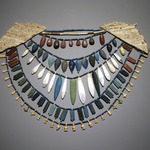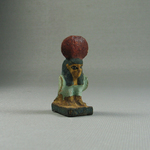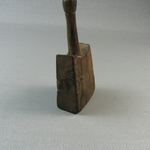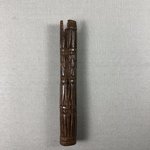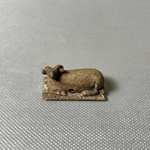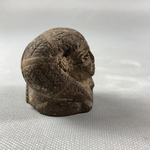

Spoon with Lotus Handle, ca. 1539–1292 B.C.E. Wood, 4 11/16 x Diam. 2 3/8 in. (11.9 x 6 cm). Brooklyn Museum, Charles Edwin Wilbour Fund, 05.314. Creative Commons-BY (Photo: Brooklyn Museum, CUR.05.314_erg456.jpg)
Spoon with Lotus Handle
Egyptian, Classical, Ancient Near Eastern Art
Spoons
Elaborate burials often included offerings of spoons with decorated bowls and handles, though their purpose is uncertain.
Early Egyptologists proposed that the spoons were used to remove solid ointments from wide-necked jars. Although many scholars still favor this traditional interpretation, others believe the spoons were cultic objects used in religious ceremonies. They probably served both functions: spoons decorated with images of birth-gods seem appropriate for domestic use; those with symbols of rebirth, such as the lotus, were probably intended for rituals.
Elaborate burials often included offerings of spoons with decorated bowls and handles, though their purpose is uncertain.
Early Egyptologists proposed that the spoons were used to remove solid ointments from wide-necked jars. Although many scholars still favor this traditional interpretation, others believe the spoons were cultic objects used in religious ceremonies. They probably served both functions: spoons decorated with images of birth-gods seem appropriate for domestic use; those with symbols of rebirth, such as the lotus, were probably intended for rituals.
MEDIUM
Wood
DATES
ca. 1539–1292 B.C.E.
DYNASTY
Dynasty 18
PERIOD
New Kingdom
DIMENSIONS
4 11/16 x Diam. 2 3/8 in. (11.9 x 6 cm) (show scale)



COLLECTIONS
Egyptian, Classical, Ancient Near Eastern Art
ACCESSION NUMBER
05.314
CREDIT LINE
Charles Edwin Wilbour Fund
CATALOGUE DESCRIPTION
Small wooden toilet spoon with round bowl and small handle in form of lotus.
Condition: Spoon appears to have been assembled from two pieces. Small fragment on rim may be restoration. Mediocre workmanship, handle chipped.
EXHIBITIONS
MUSEUM LOCATION
This item is not on view
CAPTION
Spoon with Lotus Handle, ca. 1539–1292 B.C.E. Wood, 4 11/16 x Diam. 2 3/8 in. (11.9 x 6 cm). Brooklyn Museum, Charles Edwin Wilbour Fund, 05.314. Creative Commons-BY (Photo: Brooklyn Museum, CUR.05.314_erg456.jpg)
IMAGE
overall, CUR.05.314_erg456.jpg. Brooklyn Museum photograph, 9/6/2007
"CUR" at the beginning of an image file name means that the image was created by a curatorial staff member. These study images may be digital point-and-shoot photographs, when we don\'t yet have high-quality studio photography, or they may be scans of older negatives, slides, or photographic prints, providing historical documentation of the object.
RIGHTS STATEMENT
Creative Commons-BY
You may download and use Brooklyn Museum images of this three-dimensional work in accordance with a Creative Commons license. Fair use, as understood under the United States Copyright Act, may also apply.
Please include caption information from this page and credit the Brooklyn Museum. If you need a high resolution file, please fill out our online application form (charges apply).
For further information about copyright, we recommend resources at the United States Library of Congress, Cornell University, Copyright and Cultural Institutions: Guidelines for U.S. Libraries, Archives, and Museums, and Copyright Watch.
For more information about the Museum's rights project, including how rights types are assigned, please see our blog posts on copyright.
If you have any information regarding this work and rights to it, please contact copyright@brooklynmuseum.org.
RECORD COMPLETENESS
Not every record you will find here is complete. More information is available for some works than for others, and some entries have been updated more recently. Records are frequently reviewed and revised, and we welcome any additional information you might have.
